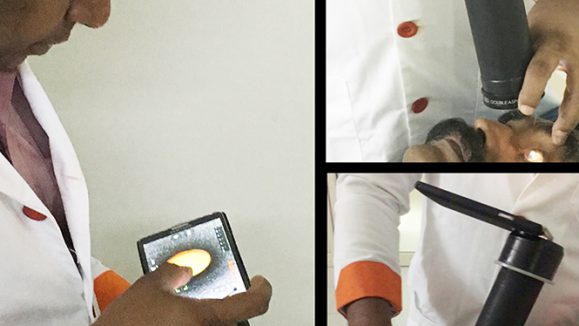On the third day of the Asia-Pacific Vitreo-retina Society (APVRS 2023) Congress, a Rapid Fire session explored the latest studies on ocular imaging, intraocular inflammation and uveitis and scleritis.
The symposium featured several groundbreaking studies promising to usher in a new era of retinal therapies. Dr. Weiting Liao’s (China) exploration of Vogt-Koyanagi- Harada (VKH) disease shed light on age-specific patterns, offering a comprehensive understanding of the disease evolution in pediatric, adult and elderly patients.
An investigation from Dr. Ting Yu’s (China) into the role of galactomannan (GM) in Aspergillus endophthalmitis (AE) highlighted the diagnostic potential of GM testing in intraocular fluid. Dr. Yue Zhang (China) challenged traditional categorizations of central serous chorioretinopathy (CSC) subtypes, emphasizing the need to distinguish acute and chronic forms based on choroidal characteristics.
And, finally, Dr. Gabriel Yang (Hong Kong, China) highlighted the potential of using deep learning on OCT images to predict the effectiveness of anti-VEGF therapy in eyes with center-involved diabetic macular edema (CI-DME).
Age-stratified VKH patterns
VKH disease represents the predominant cause of panuveitis in China. According to Dr. Liao, the clinical features of VKH disease, as reported in the current literature, predominantly focus on adult patients. As such, she and her team performed a study to compare the clinical characteristics, complications, and visual prognosis across different age groups (pediatric, adult, and elderly) among 2,571 Chinese VKH patients.
The findings revealed that within the first two weeks after the onset of uveitis, patients in all age groups (pediatric, adult, and elderly) exhibited choroiditis (100%), retinal detachment (75%, 84.2%, and 85.7%), and optic disc hyperemia. Notably, no anterior segment inflammation was observed in these VKH patients during this early stage. Between two weeks and two months after disease onset, the majority of VKH patients displayed mild to moderate non- granulomatous anterior uveitis.
Subsequently, after two months, granulomatous anterior uveitis became a prevalent manifestation across all age groups, accompanied by the significant presence of Dalen- Fuchs nodules.
“In conclusion, pediatric, adult, and elderly VKH patients demonstrated a similar disease evolutionary process. Children with VKH disease exhibited a lower frequency of manifestations in the neurological and auditory systems,” Dr. Liang shared.
“Improved visual acuity (VA) was observed across all three age groups. The association between disease onset age and a poor visual outcome revealed a reversed u-shape, with 32 years identified as the highest risk age for the development of BCVA lower than 6/18.”
In summary, this study offers a novel insight into the complete spectrum of clinical features associated with VKH disease.
Role of GM in AE diagnosis
Fungal endophthalmitis poses a critical ophthalmic emergency, demanding swift and accurate diagnosis for therapeutic success. Dr. Yu shed light on the diagnostic efficacy of GM levels in intraocular fluid, a heat-stable antigen constituting the cell wall of the Aspergillus fungi.
In a unique investigation of GM testing specifically for AE in intraocular fluid, this study aimed to provide evidence for early disease diagnosis. The retrospective analysis involved three patient groups–an AE group with positive intraocular fluid culture (n=17), a non-AE intraocular infection (NAII) group (n=20), and a negative control group (n=19).
The results unveiled significantly elevated GM levels in the AE group (5.77±1.73) compared to the NAII (0.19±0.11), and negative control (0.29±0.27) groups. The test demonstrated notable sensitivity and specificity, leading to Dr. Yu’s conclusion that GM testing in intraocular fluid serves as a rapid and reliable diagnostic modality for AE.
Redefining choroidal features in CSC subtypes
Next, Dr. Zhang challenged the traditional categorization of CSC into acute and chronic forms based on the duration of subretinal fluid (SRF) resolution. Highlighting the absence of a consensus despite various novel classification systems emerging, Dr. Zhang emphasized the importance of distinguishing between acute and chronic CSC due to potential differences in pathophysiology and management approaches.
To address this, Dr. Zhang and her colleagues set out to investigate choroidal characteristics in four recently defined subtypes of 83 CSC eyes (acute, non-resolving, recurrent and chronic CSC) through a cross- sectional observational study using swept-source optical coherence tomography angiography (SS-OCTA).
They found significant differences in best corrected visual acuity (BCVA) among the four subtypes and healthy control groups. The visual acuity (VA) of the complex CSC subgroup was significantly worse than the other four groups. Meanwhile, complex CSC had significantly lower central choroidal thickness, choroidal vascular volume (CVV), choroidal vascularity index (CVI), and choriocapillaris vessel density (CCVD).
“From the results of our study, it seems more reasonable to define chronic CSC as morphological change rather than the duration of disease, with distinctive choroid features. Traditional acute CSC tends to be ‘simple’,
with less retinal pigment epithelial disruption, and chronic CSC tends to be ‘complex’ with more [retinal pigment epithelial disruption]. Also, three- dimensional CVI and CCVD have demonstrated efficacy in evaluating choroidal vasculature serving as a promising tool for disease assessment,” Dr. Zhang explained.
OCT and anti-VEGF therapy
Last but not least, Dr. Gabriel Yang addressed the challenge of variable responses to anti-VEGF treatment in diabetic macular edema (DME), where 40% to 50% of patients do not experience improved visual acuity.

In order to identify patients who will benefit more from anti-VEGF therapy, Dr. Yang and his team developed, validated and externally tested an integral deep learning framework based on pre-treatment OCT images and clinical variables (i.e., VA and central subfield thickness [CST]) to predict the therapeutic response in patients with center-involved DME (CI-DME) after anti-VEGF injections.
Data received from three hospitals in Hong Kong were used for training and validating the algorithm. Their proposed algorithm attained the best performance in the primary validation and the external testing sets by using the first definition: ≥ 1-line gain on Snellen VA chart or >10% reduction in CST after 3 anti- VEGF injections, followed by the second definition: ≥ 1-line gain on Snellen VA chart after 3 anti-VEGF injections, and the third definition: >10% reduction in CST after 3 anti- VEGF injections.
“We demonstrated the potential use of deep learning on OCT images to predict ‘good-response’ vs. ‘no- response’ of anti-VEGF therapy in eyes with CI-DME,” Dr. Yang shared.
“This may be used as a guiding tool for therapeutic selection, thereby reducing the impact of invasive and burdensome treatment for patients in whom anti-VEGF therapy is likely to be ineffective.” – Dr. Gabriel Yang
Editor’s Note: The Asia-Pacific Vitreo-retina Society Congress (APVRS 2023) was held from December 8 to 10, 2023, at the Hong Kong Convention and Exhibition Centre, Hong Kong. Reporting for this story took place during the event. A version of this article was first published in PIE Magazine Issue 29.



